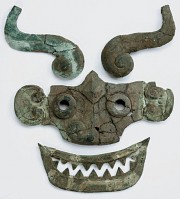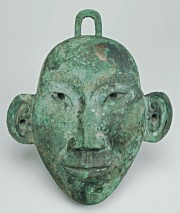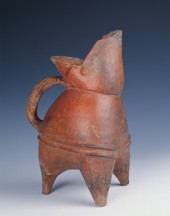|
Western Chou (mid 11th century—771 B.C.) |
|
 This area demonstrates tomb M60 and horse-and-chariot pit M3 excavated at Hsin-ts’un, Chun-hsien, Honan. M60 is among the few tombs undisturbed by looters at this Western Chou cemetery. Inside the tomb, the burial space measures 2.85m in its length and 1.6m in its width, with only a single coffin. Though not many accompanying burial artifacts are presented, the sources of these artifacts are rather complicated. Among these artifacts, there are relatively larger numbers of weapons and.....
This area demonstrates tomb M60 and horse-and-chariot pit M3 excavated at Hsin-ts’un, Chun-hsien, Honan. M60 is among the few tombs undisturbed by looters at this Western Chou cemetery. Inside the tomb, the burial space measures 2.85m in its length and 1.6m in its width, with only a single coffin. Though not many accompanying burial artifacts are presented, the sources of these artifacts are rather complicated. Among these artifacts, there are relatively larger numbers of weapons and.....
|
|
Read more...
|
|
The Ruins of Yin (Late 14th century – Mid 11th century BC) |
|
 From 1928 to 1937, the Institute conducted fifteen seasons of excavation of the Yin-hsu site. Eleven large tombs, along with more than 1300 small graves, had been discovered on the highlands of Hsi-pei-kang, located on the northern shore of the Huan River. Whereas in the Hsiao-t’un village on the southern shore of the river, three well structured hang-t’u (pounded earth) construction sites were found.
From 1928 to 1937, the Institute conducted fifteen seasons of excavation of the Yin-hsu site. Eleven large tombs, along with more than 1300 small graves, had been discovered on the highlands of Hsi-pei-kang, located on the northern shore of the Huan River. Whereas in the Hsiao-t’un village on the southern shore of the river, three well structured hang-t’u (pounded earth) construction sites were found.
The Museum separates topics of the Yin-hsu area into the “Shang Royal Cemetery at Hsi-pei-kang” and the “Shang Palace and Ancestral Temples at.....
|
|
Read more...
|
|
Lung-shan culture (2600 – 2000 BC) |
|
 In 1928, Wu Chin-ting, one of the research fellows of the Institute, first discovered the remains of the Lung-shan culture in Cheng-tze-yai, at the town Lung-shan, Shantung. Later in 1934, lead by Li Chi, other researchers of the Institute found more remains of the Lung-shan culture along the eastern coastline of Shantung Province. The next year, test excavations were carried out at the Wa-wu-ts'un and Ta-ku-tui sites in Liang-ch'eng-chen. These excavations established the foundation for the study of.....
In 1928, Wu Chin-ting, one of the research fellows of the Institute, first discovered the remains of the Lung-shan culture in Cheng-tze-yai, at the town Lung-shan, Shantung. Later in 1934, lead by Li Chi, other researchers of the Institute found more remains of the Lung-shan culture along the eastern coastline of Shantung Province. The next year, test excavations were carried out at the Wa-wu-ts'un and Ta-ku-tui sites in Liang-ch'eng-chen. These excavations established the foundation for the study of.....
|
|
Read more...
|
|
Bronze Image Rubbings Exhibition |
|
 Dates: 25 June, 2005~24 June, 2006
Dates: 25 June, 2005~24 June, 2006
Bronze vessels are precious works of traditional Chinese art but, owing to their academic importance and the difficulties of preservation, few can collect them. Because it is not easy to gain access to this art form, for centuries, enthusiasts have tried different techniques and methods attempting to reproduce the images of bronze vessels on.....
|
|
Read more...
|
|
Archaic and Masterful--Rubbings of the Han Dynasty “Wu Family Shrines” Stone Relief |
|
 Dates:2 May, 2007-30 April, 2008
Dates:2 May, 2007-30 April, 2008
The so-called ancestral shrine is a place where our forefathers are offered sacrifices and worshipped, and often situated in the proximity of one’s home for periodical offering ceremonies to remember the ancestors by, and for keeping in contact with other kinsmen and women. During the Han dynasty, the ancestral shrine used to be called, the dining hall, the temple, the study.....
|
|
Read more...
|
|
|
Xibeigang Tomb M1001:Special Exhibition for the 80th Anniversary of the Anyang Excavation Project |
|
 Dates:25 October, 2008~
Dates:25 October, 2008~
The excavation of Tomb M1001 in Xibeigang was one of the most important discoveries of the fifteen excavations that the Institute of History and Philology (IHP) carried out in Anyang. This enormous royal burial was cross-shaped with four ramps containing more human sacrifices and artifacts than in all other royal burials in Xibeigang. Repeatedly looted and damaged, its original features were beyond.....
|
|
Read more...
|
|
|
<< Start < Prev 1 2 3 4 5 6 7 8 9 10 Next > End >>
|
|
Page 8 of 13 |